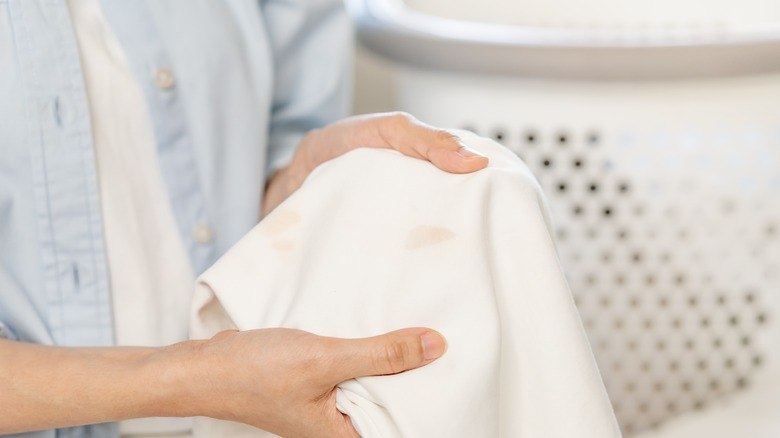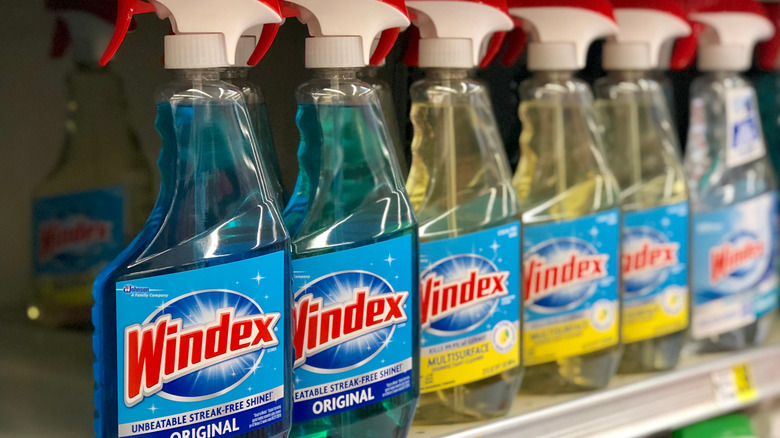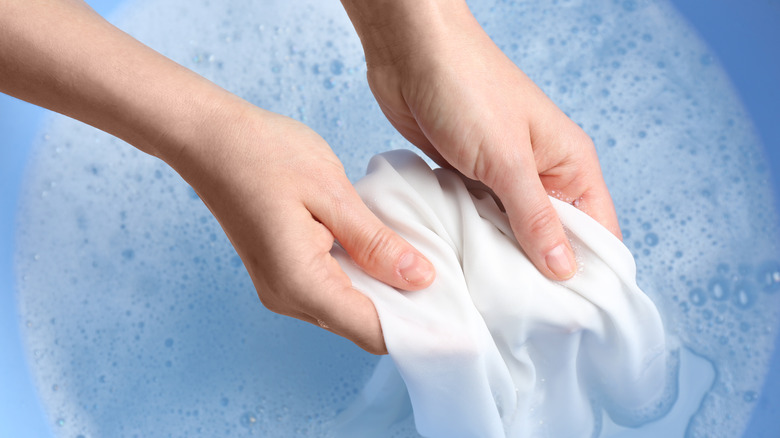The Laundry Hack That Fixes Stains With A Household Cleaner
Wouldn't it be wonderful if your home cleaning supplies could help with other tasks? Imagine if fabric softener could also clean your walls or if salad dressing moonlighted as a surface cleaner. Well, you don't have to dream about these possibilities anymore. In the era of social media hacks, homeowners are finding different uses for their cleaning products. Whether you're dealing with dust, wood furniture scratches, or wilting plants, items you find around the house can help fix common issues in ways you never thought of trying. Grist has a list of pantry-based products that can save you in a pinch, including walnuts to remove scuffs from hardwood and onions to clean a grill. But your standard cleaning sprays can also live a double life, and this hack could make you believe in thinking outside the box.
Stains are a constant nemesis to anyone who doesn't strictly wear black year round. Dealing with a spill or mark can be frustrating, but no one wants to accept defeat when their favorite pants or shirt is at stake. While any home or grocery store is sure to offer a variety of stain removers along their aisles, you might find yourself dealing with a stain on laundry day and no specialized products to be found in your armory. The good news is that you don't have to panic because one of your cleaning staples might be able to do the job just as well.
Windex can do what?
You might think of Windex as your window's best friend. Not only does it keep the eyes of your home's soul sparkling, but it makes glass surfaces and mirrors like diamonds. There is no question that this concoction is a homeowner's go-to for reflective finishes and materials, but you might not have realized its untapped potential for other uses. Windex can remove tough stains on your favorite garments, and you don't have to combine it with another cleaner or product.
Spraying food splatters and stains with clear Windex, then letting it soak for 20 minutes, will help disengage the particles and dyes that can leave behind unsightly marks on your fabrics. This window cleaner works best on machine-washable clothing and non-silk items, and Times Record notes that it is most effective with red-hued messes like ketchup or marinara sauce. That doesn't mean it can't help with other stains, but the chemicals within the spray fight even the most color-saturated foods and liquids, which is no small feat. You must use the clear product over the blue (or any alternative) because the dye from tinted Windex could end up staining the garment more.
Why it works
Windex contains ammonia, which acts as a bleaching agent on stains. On its own, ammonia can be harmful and toxic, but the store-bought cleaners have been diluted with lots of water, and the ammonia content is only around ten& or lower. While this percentage allows it to bleach out food or drink splatter, it isn't high enough to cause concern in humans. Once you've let the Windex sit on your clothing, Kitchn recommends using a clean, unused cloth to work at the stain a little more. Blot it rather than wiping, and follow up with a cold splash of water to rinse.
Lastly, throw the piece (or pieces) in the washing machine and do a full cycle. This will help remove excess Windex and work to remove the overall stain with more force and power than a handwash could. Never underestimate the power of a good machine spin, which can lift stubborn particles and debris from fibers. Windex might have started as your go-to for windows, but that doesn't mean it can't pull a little overtime now and then!


